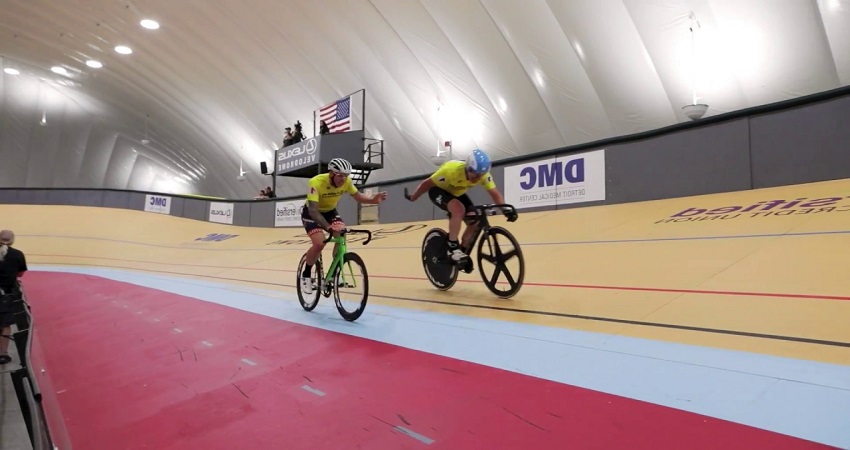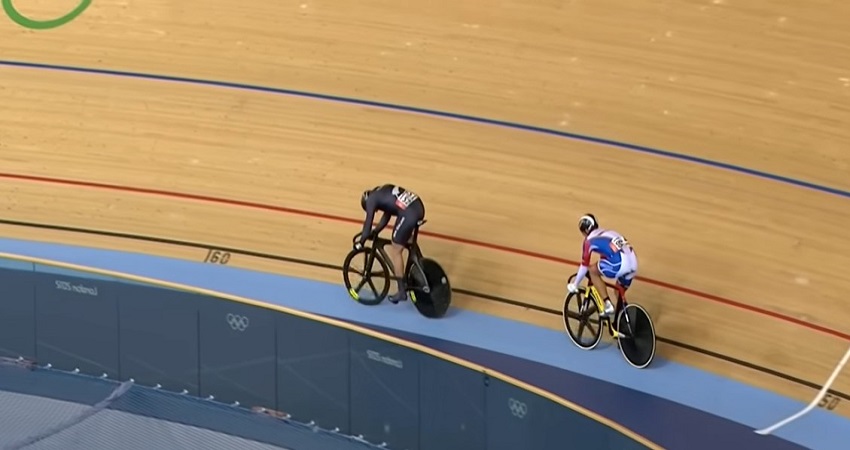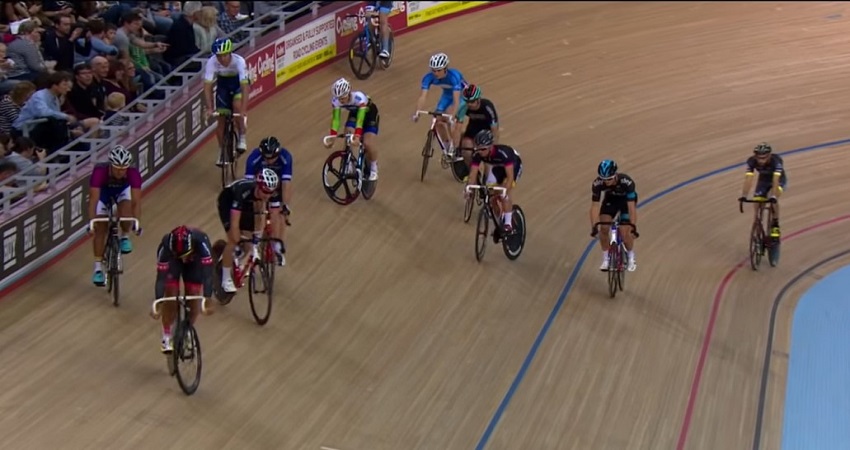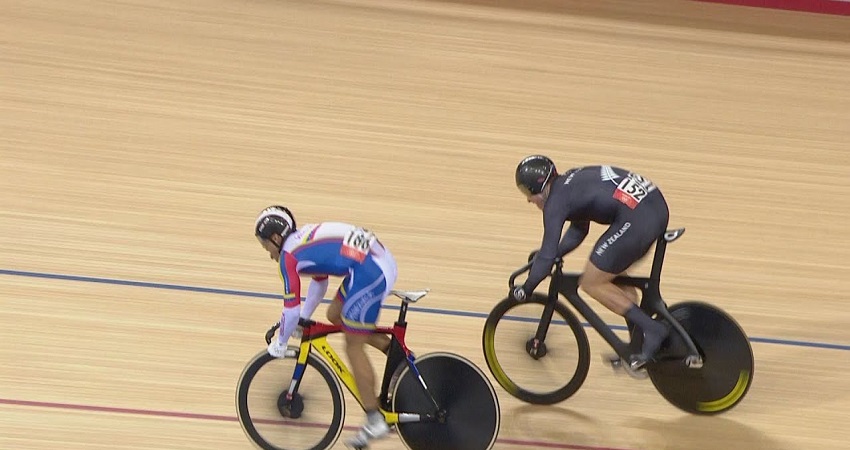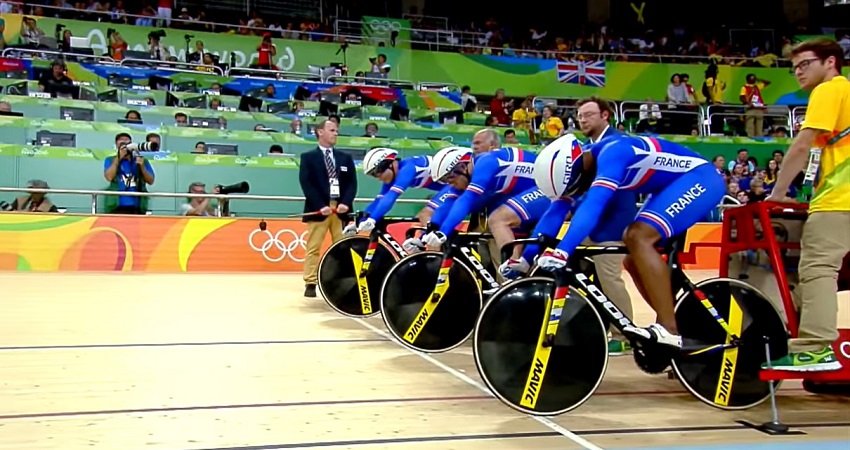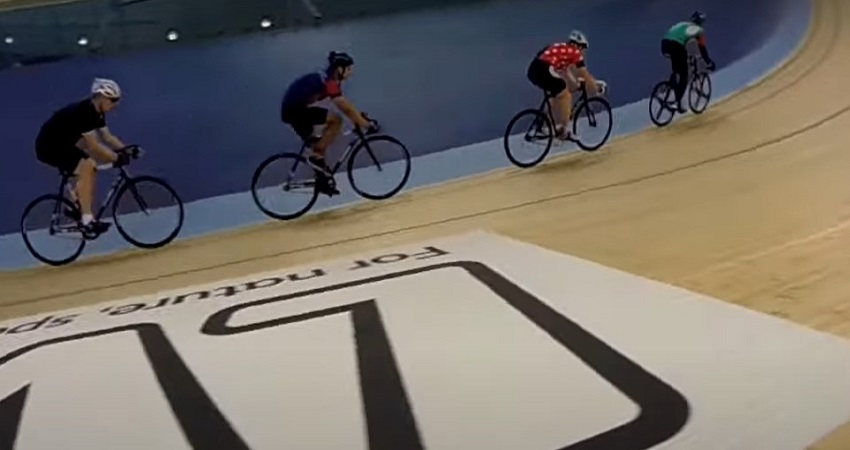
Velodrome bikes do not have brakes, as the riders do not need to come to a quick stop in a velodrome. Without brakes, riders cannot vary their speed as much, making it safer for drafting riders to follow whoever is leading them.
Velodrome bikes, optimized for racing at a velodrome or outdoor track, differ from road bicycles in several ways. One notable difference is the absence of brakes. This raises the question: do velodrome bikes have brakes? The simple answer is no.
Unlike road bicycles, velodrome bikes are fixed-gear, meaning they have only a single gear ratio and neither a freewheel nor brakes. The design of these bikes is specific to the consistent shape and smooth surface of the track, as well as the types of races ridden on it. We will explore why velodrome bikes do not require brakes and the safety implications of this design choice.
Why Do Velodrome Bikes Have No Brakes?
Velodrome bikes do not have brakes because it is safer without them. Riders in the velodrome can’t vary their speed as much, eliminating the need for quick stops. This also prevents accidents caused by sudden braking reactions.
Safety Reasons
Velodrome bikes are purposely designed without brakes for safety reasons. While it may seem counterintuitive, not having brakes actually reduces the risk of accidents on the track. With no brakes, riders cannot abruptly stop or slow down, which minimizes the chances of skidding or colliding with other cyclists. The absence of brakes also eliminates the risk of braking at the wrong time, causing a chain reaction among riders.
Drafting Advantages
One of the key advantages of a velodrome bike with no brakes is the ability to maintain consistent drafting. Drafting, or slipstreaming, is a technique where cyclists closely follow one another in order to reduce air resistance and conserve energy. Without brakes, riders can trust in the steady pace set by the leading cyclist without worrying about sudden braking that could disrupt the drafting position. This allows for smoother and more efficient riding, especially in highly competitive races.
Consistent Surface And Track Conditions
Velodromes are meticulously maintained to provide a consistent riding experience for athletes. The track surface is well-maintained and free from debris, ensuring optimal traction and control. With such consistent track conditions, riders can confidently navigate the velodrome without the need for brakes. Moreover, the absence of brakes helps to maintain the integrity of the track surface, as the constant braking and skidding associated with traditional bikes could cause wear and tear on the track over time.
Different Types Of Track Bikes
When it comes to track cycling, there are different types of track bikes designed specifically for the velodrome. These bikes are finely tuned machines that have unique features to enhance performance and speed. One of the striking differences between track bikes and regular road bikes is the absence of brakes. Let’s take a closer look at the different types of track bikes and why they don’t have brakes.
Fixed-gear Bicycles
Fixed-gear bicycles, also known as fixies, are the most common type of track bike used in velodrome racing. These bikes have a single gear and lack a freewheel, which means that the pedals move in sync with the rotation of the rear wheel. As a result, riders cannot coast or stop pedaling while in motion.
Due to the absence of a freewheel, fixed-gear bicycles have no coasting mechanism. This means that whenever the bike is in motion, the pedals are always moving. As a result, the rider has better control and responsiveness on the track, allowing for quick acceleration and seamless transitions.
Track bikes are equipped with narrow and high-pressure tires. These tires provide minimal rolling resistance and allow for maximum speed on the smooth and banked surface of the velodrome. The reduced friction from narrower tires enhances the overall efficiency and performance of the track bike, enabling competitors to reach incredible speeds.
In essence, track bikes are purpose-built machines for the velodrome, optimized for speed, agility, and control. The absence of brakes eliminates the need for sudden stops or dramatic speed adjustments, as riders on the track maintain a constant speed. This specific design ensures a seamless and safe racing experience.
Overall, track bikes offer a unique and exhilarating experience for riders on the velodrome. Their stripped-down design, fixed-gear mechanism, and lack of brakes all contribute to the high-speed intensity and precision required in track racing.
How To Stop On A Velodrome Bike
In the adrenaline-fueled world of velodrome racing, athletes push the limits of speed and skill on specialized track bikes. One key question that often arises is, do velodrome bikes have brakes? The answer is no. Velodrome bikes, also known as track bikes, do not come equipped with brakes. Although it may sound counterintuitive, this design choice is actually a safety feature. Without brakes, riders are able to maintain a consistent speed, reducing the risk of accidents caused by sudden changes in velocity.
Top Things Not To Do
When it comes to stopping on a velodrome bike, there are certain actions you should avoid. These include:
- Relying on brakes: As mentioned earlier, velodrome bikes do not have brakes. Attempting to use non-existent brakes can lead to loss of control and accidents.
- Stopping abruptly: Slamming on the pedals while riding at high speeds is not only ineffective, but it can also lead to crashes. Gradual deceleration and strategic positioning are key.
- Stopping without communication: In a velodrome race, communication is essential. Avoid sudden stops without signaling to the riders behind you, as this can cause collisions.
Techniques For Slowing Down
While velodrome bikes lack traditional braking mechanisms, there are specific techniques that riders can employ to slow down:
- Backpedaling: The track bike’s fixed gear system allows riders to backpedal, thereby increasing resistance and gradually reducing speed. By resisting the forward motion, riders can control their deceleration.
- Using the banking: Velodrome tracks are steeply banked to facilitate cornering at high speeds. By transitioning from the higher part of the track to the lower part, riders can leverage the incline to naturally slow down.
- Aerodynamic positioning: Maintaining a low and aerodynamic body position can help reduce wind resistance, which in turn lowers the speed. By maximizing their body position, riders can achieve better control over their speed.
Importance Of Body Positioning
Body positioning is crucial when it comes to stopping on a velodrome bike. By adjusting your body posture, you can effectively manage your speed. Essential body position considerations include:
- Lowering your center of gravity: Bending your elbows, crouching slightly, and tucking in your body help lower your center of gravity, which enhances stability and control during deceleration.
- Shifting your weight: To slow down, shift your weight towards the rear of the bike. This transfers weight to the rear wheel, maximizing traction and aiding in controlled deceleration.
- Maintaining grip: During deceleration, it is important to maintain a firm grip on the handlebars. This allows for better control and quick adjustments while maintaining stability.
Mastering the art of coming to a stop on a velodrome bike requires practice, precision, and understanding of track dynamics. By adhering to the techniques and body positioning principles outlined above, riders can ensure safe deceleration while pushing the boundaries of speed on the track.
Safety Considerations For Track Cycling
Velodrome bikes do not have brakes, but this is actually safer for track cycling. Without brakes, riders do not have the ability to suddenly stop, reducing the risk of accidents and collisions. Additionally, it promotes consistent speed among riders, which is important in a drafting race format.
Importance Of Proper Safety Check
When participating in track cycling, it is crucial to prioritize safety. One of the key aspects of ensuring a safe ride is conducting a proper safety check before hitting the velodrome. This involves inspecting various components of your track bike to ensure they are in good working condition.
Here are some important areas to focus on during your safety check:
- Tyre pressure: Maintaining the correct tyre pressure is vital for optimal performance and stability on the track. It is recommended to check the tyre pressure before each ride.
- Bike setup: Make sure that your bike is properly adjusted to your body measurements and riding style. This includes checking the saddle height and position, handlebar alignment, and pedals.
- Inspect brakes: Although track bikes do not typically have brakes, it is still essential to check the braking system, if present, to ensure it is not causing any interference or safety hazards.
- Tighten bolts and screws: Verify that all bolts and screws on your bike are securely tightened. Loose components can compromise your safety and performance on the velodrome.
Understanding Track Rules And Techniques
Track cycling involves various racing disciplines, each with its own specific rules and techniques. Before venturing onto the velodrome, it is vital to familiarize yourself with these rules to ensure a safe and enjoyable experience.
Here are some key areas to focus on:
| Discipline | Rules and Techniques |
| Sprint racing | Sprint racing involves short, intense bursts of speed. Understanding the strategy and tactics used in sprint races is essential for both your safety and success on the track. |
| Keirin | Keirin races are popular in Japan and involve a pacing motorcycle. Learning how to position yourself effectively behind the motorcycle and execute controlled sprints is key in Keirin racing. |
| Individual pursuit | In individual pursuit, riders race against the clock. Mastering the art of pacing and maintaining a steady rhythm throughout the race is crucial for a successful pursuit. |
Benefits Of Simplicity In Track Bikes
A significant characteristic of track bikes is their simplicity. Unlike road bicycles, track bikes are fixed-gear and do not have brakes. While this may seem unconventional, it actually offers several benefits in terms of safety:
- Consistent speed: Without brakes, track cyclists cannot abruptly change their speed, reducing the risk of collisions due to sudden stops.
- Drafting advantage: Riders can take advantage of drafting, where they closely follow the cyclist in front of them to reduce air resistance. A predictable speed without brakes makes drafting more effective and safer.
- Enhanced bike control: Riding a fixed-gear bike without brakes requires improved bike handling skills. This helps track cyclists develop precise control over their bikes, enhancing their safety and performance on the track.
By understanding the importance of safety checks, familiarizing yourself with track rules and techniques, and appreciating the benefits of simplicity in track bikes, you can ensure a safe and enjoyable experience in the velodrome.
Track Cycling Vs Road Cycling
When it comes to the world of cycling, there are two popular forms that enthusiasts can choose from – track cycling and road cycling. While both are exhilarating and require skill, they differ in many aspects, including equipment, types of races, and techniques used. In this blog post, we will explore the key differences between track cycling and road cycling.
Differences In Equipment
Track cycling and road cycling require different types of equipment. In track cycling, specifically on a velodrome, the bikes used are called track bikes. These bikes are fixed-gear and do not have brakes. The absence of brakes may sound concerning to some, but it is actually safer on the velodrome, as riders don’t need to come to a quick stop. Without brakes, the riders can’t vary their speed as much, eliminating the need for abrupt stops which can cause accidents.
On the other hand, road cycling bikes or road bikes are designed for riding on paved roads, including hills and long distances. Road bikes are equipped with multiple gears, allowing cyclists to adjust their speed according to the terrain. They also have brakes, essential for safe riding on roads where sudden stops may be necessary.
Types Of Races And Techniques
The types of races and techniques used in track cycling and road cycling also differ. Track cycling races take place on a velodrome, a closed circular track, and can include sprint events, endurance events, and team events. These races require cyclists to ride in close proximity to one another at high speeds, making precise maneuvering and drafting essential skills.
In contrast, road cycling races take place on open roads and can include a variety of events such as road races, time trials, and criteriums. Road cyclists need to navigate different terrains, including climbs and descents, and strategize their efforts to stay ahead of the competition.
Advantages And Challenges Of Each
Track cycling and road cycling each come with their own set of advantages and challenges. For track cycling, the absence of brakes allows for a more streamlined riding experience, with less focus on deceleration and more emphasis on consistent speed. This can make it a thrilling and fast-paced sport, perfect for those seeking adrenaline.
On the other hand, road cycling provides the opportunity to explore different landscapes and enjoy the freedom of riding on open roads. The inclusion of gears and brakes gives riders more control over their speed and allows for more versatility in navigating various terrains. However, road cycling also poses challenges such as traffic, weather conditions, and potential hazards on the road.
In conclusion, track cycling and road cycling have their own unique characteristics and offer distinct experiences for cyclists. Whether you prefer the controlled intensity of the velodrome or the freedom of the open road, both forms of cycling provide an exhilarating way to stay fit and enjoy the sport.
Frequently Asked Questions For Do Velodrome Bikes Have Brakes?
Why Do Velodrome Bikes Have No Brakes?
Velodrome bikes don’t have brakes because it’s safer without them. Riders can’t vary their speed as much, reducing the need to abruptly stop. This prevents accidents from sudden changes in speed. The shape and surface of the track also make brakes unnecessary.
How Do You Stop On A Velodrome Bike?
Velodrome bikes do not have brakes. This is because on a velodrome track, there is no need to come to a quick stop. Without brakes, riders cannot vary their speed as much and are less likely to slam on their brakes in response to changes in speed.
This makes it safer for riders.
Do Olympic Bikes Have Brakes?
Track bicycles used in Olympic events do not have brakes. This is because the smooth track surface and specific racing rules make brakes unnecessary. Without brakes, riders cannot vary their speed as much, creating a safer racing environment. These bikes are fixed-gear and have a single gear ratio.
They also have narrow tires inflated to high pressure for reduced rolling resistance.
How Do You Stop A Track Bike?
Track bikes do not have brakes. This is because they are optimized for racing at a velodrome or outdoor track, where the consistent shape and smooth surface of the track make brakes unnecessary. Without brakes, riders can’t vary their speed as much, ensuring a safer race environment.
Conclusion
Velodrome bikes do not have brakes, and this is actually a safety feature rather than a disadvantage. Without brakes, riders are unable to make sudden stops, which prevents accidents on the track. Additionally, the design of the track and the nature of the races ridden on it make brakes unnecessary.
Velodrome bikes are optimized for racing and have fixed-gears, providing a unique and thrilling experience for riders. With their narrow, high-pressure tires and lack of brakes, velodrome bikes offer a specialized and exhilarating ride for cycling enthusiasts.
